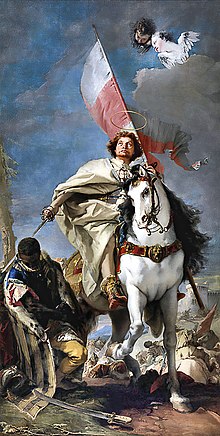
Alfonso II of Asturias, nicknamed the Chaste, was the king of Asturias during two different periods: first in the year 783 and later from 791 until his death in 842. Upon his death, Nepotian, a family member of undetermined relation, attempted to usurp the crown in place of the future Ramiro I.

The Kingdom of Asturias was a kingdom in the Iberian Peninsula founded by the Visigothic nobleman Pelagius. It was the first Christian political entity established after the Umayyad conquest of Visigothic Hispania in 718. That year, Pelagius defeated an Umayyad army at the Battle of Covadonga, in what is usually regarded as the beginning of the Reconquista.
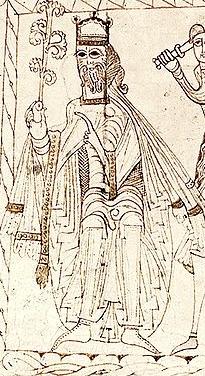
Alfonso VII, called the Emperor, became the King of Galicia in 1111 and King of León and Castile in 1126. Alfonso, born Alfonso Raimúndez, first used the title Emperor of All Spain, alongside his mother Urraca, once she vested him with the direct rule of Toledo in 1116. Alfonso later held another investiture in 1135 in a grand ceremony reasserting his claims to the imperial title. He was the son of Urraca of León and Raymond of Burgundy, the first of the House of Ivrea to rule in the Iberian peninsula.
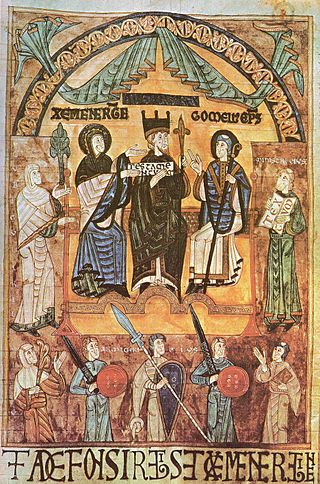
Alfonso III, called the Great, was the king of León, Galicia and Asturias from 866 until his death. He was the son and successor of Ordoño I. In later sources he is the earliest to be called "Emperor of Spain." He was also titled "Prince of all Galicia".

James the Great was one of the Twelve Apostles of Jesus. According to the New Testament, he was the second of the apostles to die, and the first to be martyred. Saint James is the patron saint of Spain and, according to tradition, his remains are held in Santiago de Compostela in Galicia.

Ramiro I was king of Asturias from 842 until his death in 850. Son of King Bermudo I, he became king following a succession struggle after his predecessor, Alfonso II, died without children. During his turbulent reign, he fended off attacks from both Vikings and Moors. Architecturally, his recreational palace Santa María del Naranco and other buildings used the ramirense style that prefigured Romanesque architecture. He was a contemporary of Abd ar-Rahman II, Umayyad Emir of Córdoba.

Simancas is a town and municipality of central Spain, located in the province of Valladolid, part of the autonomous community of Castile and León. It is situated approximately 10 km southwest of the provincial capital Valladolid, on the road to Zamora and the right bank of the river Pisuerga.
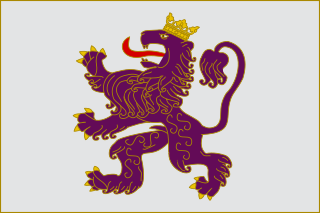
The Kingdom of León was an independent kingdom situated in the northwest region of the Iberian Peninsula. It was founded in 910 when the Christian princes of Asturias along the northern coast of the peninsula shifted their capital from Oviedo to the city of León. The kings of León fought civil wars, wars against neighbouring kingdoms, and campaigns to repel invasions by both the Moors and the Vikings, all in order to protect their kingdom's changing fortunes.
This is a historical timeline of Portugal.
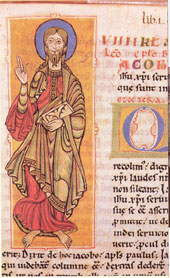
The Codex Calixtinus is a manuscript that is the main witness for the 12th-century Liber Sancti Jacobi, a pseudepigraph attributed to Pope Calixtus II. The principal author or compiler of the Liber is thus referred to as "Pseudo-Calixtus", but is often identified with the French scholar Aymeric Picaud. Its most likely period of compilation is 1138–1145.

The Iberian Peninsula, where Galicia is located, has been inhabited for at least 500,000 years, first by Neanderthals and then by modern humans. From about 4500 BC, it was inhabited by a megalithic culture, which entered the Bronze Age about 1500 BC. These people would become the Gallaeci, and they would be conquered by the Roman Empire in the first and second centuries AD. As the Roman Empire declined, Galicia would be conquered and ruled by various Germanic tribes, notably the Suebi and Visigoths, until the 9th century. Then the Muslim conquest of Iberia reached Galicia, although they never quite controlled the area.

The Cross of Saint James, also known as the Santiago cross, cruz espada, or Saint James' Cross, is a cruciform (cross-shaped) heraldic badge. The cross, shaped as a cross fitchy, combines with either a cross fleury or a cross moline. Its most common version is a red cross resembling a sword, with the hilt and the arm in the shape of a fleur-de-lis.

The Battle of Clavijo is a mythical battle, which was believed for centuries to be historical, and it became a popular theme of Spanish traditions regarding the Christian expulsion of the Muslims. The stories about the battle are first found centuries after it allegedly occurred; according to them, it was fought near Clavijo between Christians, led by Ramiro I of Asturias, and Muslims, led by the Emir of Córdoba. Modern historians no longer believe the battle to be historical. The Diccionario de historia de España said that "To a serious historian, the existence of the Battle of Clavijo is not even a topic of discussion".
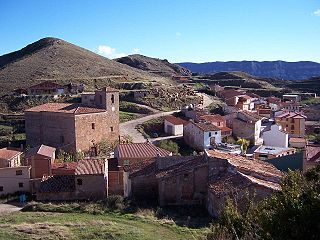
Clavijo is a municipality of the autonomous community of La Rioja (Spain). It is located near the capital, Logroño. As of 2009, its population was of 276 inhabitants.

The Battle of Monte Laturce, also known as the second Battle of Albelda, was a victory for the forces of Ordoño I of Asturias and his ally García Íñiguez of Pamplona. They defeated the latter's uncle and former ally, the Banu Qasi lord of Borja, Zaragoza, Terrer, and Tudela, Navarre, Musa ibn Musa al-Qasawi, a marcher baron so powerful and independent that he was called by an Andalusi chronicler "The Third King of the Spains" (Spaniae). The battle took place during the Asturian siege of a new fortress under construction by Musa at Albelda de Iregua. The fortress was taken a few days after the battle. After Monte Laturce, Musa was forced to fully submit to the Emir of Córdoba, who took advantage of Musa's weakness to remove him as wāli of the Upper March, initiating a decade-long eclipse of the Banu Qasi.

¡Santiago!, is a Christian rallying cry of Spanish soldiers during the Reconquista and crusading era of medieval Spain. The phrase, "¡Santiago y cierra España!" — literally, "St. James and Seal Spain!" or "Santiago and close Spain!" was an appeal to St. James to intercede in closing Spain's borders from foreign bodies and invasion. Contrary to this interpretation there are other authors who argue that the military order closes, in military terms means to engage in combat, attack or attack; "Close" the distance between you and the enemy. St. James became the patron of Spain, and the hope and the mainstay of the Christian people in times of stress, war and threatening ruin.
The tribute of 100 virgins is a Spanish national myth as part of the Reconquista ideology. The legend rests on a narrative of annual tribute of one hundred virgin maidens paid by the Christian kingdom of Asturias to the Muslim emirate of Córdoba. The narrative also suggests that fifty were to be of noble birth and fifty commoners. The myth of tribute has been described "historically apocryphal but ideologically accurate" because it played important propaganda role in the formation and affirmation of the Reconquista ideology in the later Middle Ages, and it still figures prominently to this day in Spanish national cultural memory.
The Voto de Santiago was an offering rendered by the Christian kingdoms of Asturias, Galicia, León and Castille to Saint James and his cathedral at Santiago de Compostella in thanks for the saint's miraculous intervention, which they believed had enabled them to win the legendary battle of Clavijo against the Moors. The battle had resulted from his refusal to pay the Tribute of 100 Damsels to the Emirate of Córdoba.
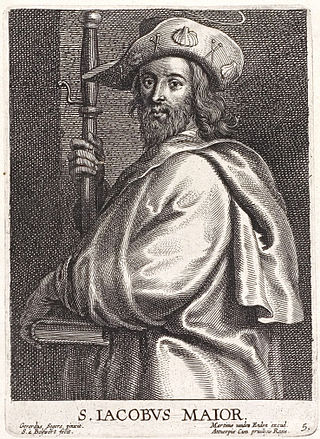
The Feast of Saint James, also known as Saint James' Day, is a commemoration of the apostle James the Great celebrated on July 25 of the liturgical calendars of the Roman Catholic church and of the Anglican, Lutheran and some other Protestant churches. The Orthodox Christian liturgical calendar commemorates James on April 30.
